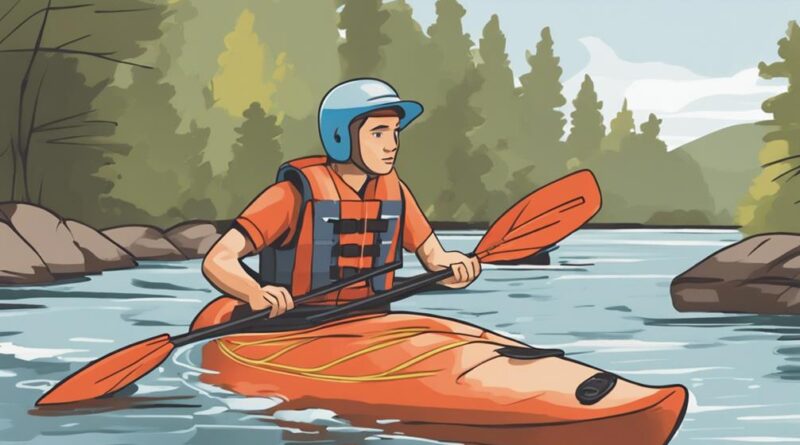6 Best Safety Tips for Beginner River Kayakers
Embark on your river kayaking journey with these 6 best safety tips for beginners. From gear essentials to understanding currents, each tip is crucial for your aquatic adventures.
But remember, one vital safety aspect often overlooked can make all the difference between a smooth glide and a turbulent turn. Stay tuned to uncover this underrated tip that can truly enhance your river kayaking experience and keep you safe on the water.
River Kayaking Basics
When navigating rivers in a kayak, mastering basic paddling techniques is essential for your safety and enjoyment. River navigation requires understanding how to steer your kayak efficiently through currents and obstacles. To navigate effectively, use your paddle as a rudder by dragging it lightly in the water on the side you want to turn towards. This technique helps you maneuver around rocks and other hazards smoothly.
Additionally, learning to read the flow of the river is crucial. Identify calm areas for resting and plan your route to avoid strong currents that may tire you out.
Equipment maintenance is another key aspect of river kayaking basics. Before setting out, always check your gear for any signs of wear and tear. Inspect your kayak for cracks, ensure your paddle is in good condition, and verify that your safety equipment such as a life jacket and helmet are functioning correctly. Regularly maintain and clean your equipment to prolong its lifespan and keep you safe on the water. Remember, a well-maintained kayak and gear are essential for a smooth and enjoyable kayaking experience.
Essential Gear Checklist
To ensure your safety and preparedness on the water, make sure you have all the essential gear listed in this checklist. Start with a reliable personal flotation device (PFD) that fits snugly and comfortably. Your PFD is a crucial piece of equipment that could potentially save your life in case of a mishap.
Next, invest in a sturdy kayak helmet to protect your head from any unexpected impacts. Additionally, it's essential to have a quality paddle that suits your height and the type of kayaking you'll be doing.
Other important items to include in your gear checklist are a bilge pump for removing any excess water from your kayak, a whistle for signaling in case of emergencies, and a throw rope to assist others or yourself in challenging situations. Remember to regularly check and maintain your gear to ensure everything is in good working condition.
Proper storage of your equipment is also key to prolonging its lifespan and effectiveness. Store your gear in a dry and well-ventilated area to prevent mold or mildew from developing.
Understanding River Currents
Once you're out on the water with your essential gear in check, understanding river currents is vital for a safe and enjoyable kayaking experience. Here are a few key points to consider:
- Water Dynamics: Rivers are constantly in motion, and understanding how water moves in a river is essential. Learn about concepts like eddies, rapids, and river bends to navigate effectively.
- Current Hazards: Be aware of potential dangers such as strong currents, strainers (obstacles that allow water to pass but trap solid objects), and undercut rocks (rocks with gaps beneath them where water can flow). Knowing how to identify and avoid these hazards is crucial for your safety.
- Reading the River: Pay attention to the flow of the water, the shape of the riverbed, and any obstacles in your path. By reading the river effectively, you can anticipate changes in the current and make informed decisions about your route.
Safety Precautions Before Launching
Make sure to conduct a thorough inspection of your kayak and gear before setting off on the river to ensure everything is in proper working condition. Check for any damages, make sure all equipment is securely fastened, and that you have all the necessary items for a safe journey.
Proper hydration is crucial, so bring an adequate amount of water to stay hydrated throughout your trip. Apply sunscreen to protect your skin from the sun's harmful rays, especially if you'll be out on the water for an extended period.
Before launching, it's essential to inform an emergency contact of your plans. Share your intended route and estimated return time with them. It's also wise to carry a river map to familiarize yourself with the waterway and potential hazards. Knowing the river's layout can help you navigate safely and effectively.
In addition to these precautions, ensure you have essential safety gear on board, such as a life jacket and a whistle. Familiarize yourself with how to use this equipment in case of an emergency. By taking these steps before launching, you'll be better prepared to handle any challenges that may arise on the river. Stay safe and enjoy your kayaking adventure!
Paddling Techniques for Beginners
Before you start practicing your paddling techniques as a beginner river kayaker, it's important to understand the basics of how to maneuver your kayak effectively on the water. To help you get started, here are some key tips to enhance your paddling skills:
- Basic Strokes: Learning fundamental paddling strokes such as the forward stroke, backward stroke, sweep stroke, and draw stroke is essential for controlling your kayak and navigating different water conditions effectively.
- Proper Posture: Maintaining the right posture while kayaking not only improves your paddling efficiency but also helps prevent fatigue and injuries. Sit upright with your back straight, shoulders relaxed, and engage your core muscles for stability.
- Practice, Practice, Practice: Like any skill, mastering kayaking techniques requires practice. Spend time on calm waters to hone your strokes, experiment with different techniques, and gradually build your confidence on the water.
Dealing With Emergency Situations
In emergency situations while kayaking, swift and decisive actions can be crucial for ensuring your safety and that of others on the water. It's important to be prepared and know how to handle potential emergencies that may arise during your kayaking adventures.
One key aspect of dealing with emergency situations is understanding emergency signals and communication methods. Make sure you're familiar with commonly used signals such as waving your paddle overhead to signal for help. Carrying a whistle and knowing how to use it can also be vital in alerting others to your distress.
Additionally, having basic first aid knowledge is essential for addressing injuries that may occur while kayaking. Pack a waterproof first aid kit and know how to use its contents for treating minor cuts, scrapes, or burns. It's also important to be prepared for more serious injuries by taking a first aid course that includes instruction on managing fractures, sprains, or head injuries.
Weather Monitoring Tips

Understanding how to monitor and interpret weather conditions is crucial for ensuring a safe and enjoyable kayaking experience. Being prepared and aware of the weather can help you make informed decisions and prevent potential hazards. Here are some essential weather monitoring tips for beginner river kayakers:
- Check the Forecast: Before heading out, always check the weather forecast for the day. Look for any warnings or alerts that may affect your kayaking trip.
- Observe the Sky: Keep an eye on the sky throughout your paddling adventure. Darkening clouds, sudden changes in wind direction, or rapid drops in temperature can indicate an incoming storm.
- Listen for Thunder: If you hear thunder, it's a sign that lightning may be nearby. Head to shore immediately and wait until the storm passes before continuing your journey.
Responsible River Etiquette
When kayaking on rivers, always show respect for other paddlers, wildlife, and the environment by following responsible river etiquette. River conservation is crucial to maintaining the natural beauty and health of these waterways. Avoid littering or disturbing the riverbed to preserve the ecosystem for future generations of paddlers and wildlife.
Responsible river etiquette also extends to wildlife encounters. Keep a safe distance from animals you may encounter while kayaking, such as birds, fish, or even larger mammals like deer or beavers. Observing wildlife from afar without causing distress helps to maintain the natural behavior and habitats of these creatures.
Additionally, be mindful of other paddlers sharing the river with you. Practice good communication and cooperation, especially in narrow or challenging sections where passing can be difficult. Yielding the right of way to others when necessary ensures a safe and enjoyable experience for everyone on the river.
Frequently Asked Questions
What Are Some Common Mistakes That Beginner River Kayakers Should Avoid?
When kayaking on rivers, it's important to avoid common pitfalls such as overestimating your abilities or neglecting safety gear. Focus on proper technique and skill development to navigate safely. Stay aware of your surroundings, avoid distractions, and always wear a personal flotation device.
Make sure to check weather conditions before heading out and paddle with a buddy whenever possible. By being prepared and cautious, you can enjoy your river kayaking experience to the fullest.
Are There Any Specific Stretches of River That Are More Suitable for Beginners?
When starting out, stick to calmer river sections that are beginner-friendly. Look for gentle currents and minimal obstacles. It's essential to have the best gear for safety, like a reliable kayak and a well-fitted life jacket.
Proper training is key to navigating rivers successfully. As you gain experience, you can gradually explore more challenging stretches. Remember, safety first and always be prepared for unexpected situations on the water.
How Can Kayakers Ensure They Are Properly Prepared for Unexpected Changes in Weather Conditions?
To ensure you're ready for unexpected weather changes while kayaking, prioritize emergency preparedness. Pack essential safety gear like a whistle, first aid kit, and a waterproof communication device.
Stay updated on weather forecasts before hitting the water and be prepared to adjust your plans accordingly. Keep an eye out for changing weather conditions while navigating the river, and always prioritize your safety above all else.
What Should Beginners Do if They Encounter Wildlife While Kayaking on a River?
If you encounter wildlife while kayaking on a river, prioritize safety precautions. Stay calm and avoid sudden movements.
Give animals space and don't feed them. Be aware of your surroundings and respect their habitat.
Carry bear spray or other deterrents if paddling in bear country. Remember, wildlife encounters can be unpredictable, so always be prepared and prioritize safety for both yourself and the animals.
Are There Any Specific Rules or Regulations That Beginner Kayakers Should Be Aware of Before Heading Out on the Water?
Before hitting the water, make sure you know river etiquette and have your safety gear ready.
Be aware of local regulations and always follow them.
Familiarize yourself with emergency procedures in case things go awry.
Conclusion
Remember, safety should always be your top priority when venturing out on the river in a kayak.
By following these six essential tips for beginner kayakers, you can enjoy your time on the water while minimizing risks and staying prepared for any unexpected situations.
Always remember to check the weather, wear proper gear, understand river currents, and practice good paddling techniques.
Stay safe and have fun exploring the beautiful rivers!
